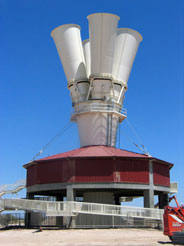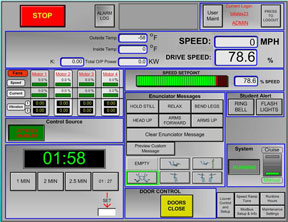Thrill seekers around the world are forever looking for the next big adrenaline rush. More of them are finding that thrill through indoor skydiving, which is quickly becoming a way to satisfy the desire for excitement, and yet remove the element of danger.
Indoor Skydiving
Indoor skydiving facilities have been in existence globally for several years. However, the controls have been known to be sluggish, undependable, limited in features, and inefficient.
Engineering partners Frank Smith and Bill Alexander of Custom Control Solutions, LLC, in Cumming, GA have developed a newer control system for indoor skydiving tunnels that emphasizes safety and efficiency. The system creates and monitors a smooth air stream which simulates atmospheric properties suitable for skydiving. Frank and Bill have been busy installing systems throughout America, as well as internationally in locations such as Alcantarilla, Spain, Milton Keynes, England, and Moscow.
With its unique architecture, the indoor skydiving structure looks rather unusual. A little over four stories tall, the first floor of the structure consists mainly of open framework, with the exception of a large enclosed bell-like structure at the bottom resembling a space shuttle exhaust. A stairway leads to the second floor which houses the control room, classrooms, and sales center, all surrounding a central circular chamber (the tunnel). Farther up, sitting atop the structure, are four large exhaust fans, designed to pull air up through the central tunnel and exhaust it out the top. This section of the tower houses four 400 hp fans, each controlled by a dedicated Variable Frequency Drive (VFD) located within the structure below. When the fans run simultaneously, internal wind speeds can reach 178 mph.
 The indoor skydiving tunnels are open to the general public where customers must first attend class and learn how to tunnel sky dive. Experienced skydivers use the facilities to refine existing skills, and teams around the world use them to create and practice in-air routines with relative safety and without time limitations. According to Alexander, in 30 minutes a skydiving team could practice as many as 15 dives, as opposed to the several hours it would take from an airplane.
The indoor skydiving tunnels are open to the general public where customers must first attend class and learn how to tunnel sky dive. Experienced skydivers use the facilities to refine existing skills, and teams around the world use them to create and practice in-air routines with relative safety and without time limitations. According to Alexander, in 30 minutes a skydiving team could practice as many as 15 dives, as opposed to the several hours it would take from an airplane.
The new control system features a PC-based control system with Entivity Studio as both the logic engine and the Human Machine Interface (HMI). The master industrial PC communicates to inputs and outputs (I/O) using an Ethernet connection and collects data from the VFDs using RS-485 Modbus communications. The control system provides the operator with a combination of touch-screen and manual flight controls.
Each VFD is built into a packaged configuration which includes an 18-pulse transformer, input reactor, and high-energy surge protection. The VFDs are controlled via analog and digital signals and the control system receives information over the Modbus link on drive status, faults, power consumption, etc.
For increased safety, most tunnels are equipped with photoelectric sensors, located at specific heights, to help maintain airspeed. If the flier exceeds a predetermined level in the flight chamber, the sensors report to the control system and the fan speed is automatically adjusted to bring the flier back down to a safe area within the tunnel.
 The control system was designed so the operator has a full overview of system status from one main screen. The main screen is divided into functional areas, which help reduce eye fatigue by placing information where the operator doesn’t have to constantly scan the screen. Setup screens are provided for system configuration such as PID tuning, speed limits, door opening and closing times, etc. The operator controls the flight of the skydiver in the tunnel using a joystick co-located with the control computer.
The control system was designed so the operator has a full overview of system status from one main screen. The main screen is divided into functional areas, which help reduce eye fatigue by placing information where the operator doesn’t have to constantly scan the screen. Setup screens are provided for system configuration such as PID tuning, speed limits, door opening and closing times, etc. The operator controls the flight of the skydiver in the tunnel using a joystick co-located with the control computer.
The control system features Ethernet I/O, enclosures, pushbuttons, switches and terminal blocks from AutomationDirect. The DirectLOGIC DL205 hardware platform was chosen for the application based on its wide selection of I/O modules, size, cost and reliability, and ease of integration with Entivity Studio software. A PLC base houses an Ethernet Base Controller (EBC) module in the CPU slot. The program logic is executed in the PC and the I/O rack becomes a transparent extension of the PC itself.
 In Milton Keynes, England, the skydiving tunnel uses a different design. The fans are installed horizontally and force recirculated air through outer towers back into the central tunnel. Friction caused by the recirculation heats the air, so each tower is equipped with an adjustable vent door, allowing exhaust of heated air and intake of outside air to control tunnel air temperatures. Alexander states, “For every liter of air I put out through the exhaust door, it pulls in fresh air.” To explain efficiency, he continues, “A four minute flight typically uses less than a dollar of electricity. The efficiency ratio is incredible for the amount of airspeed that’s generated.”
In Milton Keynes, England, the skydiving tunnel uses a different design. The fans are installed horizontally and force recirculated air through outer towers back into the central tunnel. Friction caused by the recirculation heats the air, so each tower is equipped with an adjustable vent door, allowing exhaust of heated air and intake of outside air to control tunnel air temperatures. Alexander states, “For every liter of air I put out through the exhaust door, it pulls in fresh air.” To explain efficiency, he continues, “A four minute flight typically uses less than a dollar of electricity. The efficiency ratio is incredible for the amount of airspeed that’s generated.”
The combination of AutomationDirect I/O, Entivity Software, and VFDs has resulted in a reliable, expandable, and cost-effective control system solution. Since September 2003, the newer control system has logged near-perfect up-time. The wind tunnels operate 24 hours a day, 7 days a week, and host scores of tourists and skydiving teams from around the world.
For more information about the skydiving tunnel or other services from Custom Control Solutions, contact Bill Alexander, 3550 North Parkway Suite 300, Cumming, GA 30040. Phone 770-886-3307, fax 770-886-3882 or email billa@ccsolutionsllc.net.
By TJ Johns,
Senior Editor
Originally Published: Dec. 1, 2007

